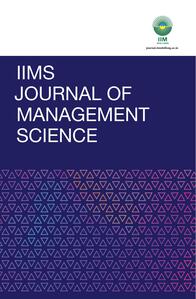
1 Amity Business School, Amity University, Noida, Uttar Pradesh, India
Creative Commons Non Commercial CC BY-NC: This article is distributed under the terms of the Creative Commons Attribution-NonCommercial 4.0 License (http://www.creativecommons.org/licenses/by-nc/4.0/) which permits non-Commercial use, reproduction and distribution of the work without further permission provided the original work is attributed.
The term “employee engagement” represents a broad construct which covers various facets of human resource management, focusing on the strategic initiatives being undertaken by organizations to build trust and reputation among its employees. Despite of the available text on the subject, concrete explanation of the concept still remains. Although much has been written on the subject, yet it remains inconsistently defined and conceptualized. It is a strong factor that impacts employee’s commitment towards the organization, his wellness, and job performance, further laying the foundation of organizational success. It becomes even more relevant in the current time of pandemic when the entire world is facing turbulence and there is a lot of apprehension in the mind of the employees in regard of their financial stability and job security. This article attempts to explore, compile, and present the various engagement strategies generally adopted by companies and newer approaches used during this COVID-19 period using an integrated and comprehensive literature review on the basis of research papers, blogs, articles, newsletters, and reports of various organizations.
Employee engagement, engagement strategies, well-being, COVID-19, pandemic
Avery, D. R., McKay, P. F, & Wilson, D. C. (2007). Engaging the aging workforce: The relationship between perceived age similarity, satisfaction with co-worker and employee Engagement. Journal of Applied Psychology, 25(9), 1542–1556. https://psycnet.apa.org/record/2007–16921–006
Bhattacharyya, R., Verma, P., & Basu, S. D. (2020). In times of COVID-19, top companies give priority to employees’ wellbeing. ET Bureau. Retrieved from https://economictimes.indiatimes.com/news/company/corporate-trends/in-times-of-covid–19-crisis-top-companies-give-priority-to-employees-wellbeing/articleshow/74964709.cms?from=mdr
Brown, R. (2006). Doing your dissertation in business and management: The reality of researching and writing. SAGE Publications.
Chanana, N., & Sangeeta. (2020). Employee engagement practices during COVID-19 lockdown. Journal of Public Affairs, e2508. https://doi.org/10.1002/pa.2508
Corporate Leadership Council. (2004). Driving performance and retention through employee engagement. Corporate Executive Board 32. https://www.stcloudstate.edu/humanresources/_files/documents/supv-brown-bag/employee-engagement.pdf
Dahik, A., Lovich, D., Kreafle, C., Bailey, A., Kilmann, J., Kennedy, D., Roongta, P., Schuler F., Tomlin, L., & Wenstrup, J. (2020). What 12,000 employees have to say about the future of remote work. Retrieved from https://www.bcg.com/en-in/publications/2020/valuable-productivity-gains-covid–19
De-la-Calle-Durán, M. C., & Rodríguez-Sánchez, J. L. (2021). Employee engagement and wellbeing in times of COVID-19: A proposal of the 5Cs model. International Journal of Environmental Research and Public Health, 18(10), 5470. https://www.mdpi.com/1660–4601/18/10/5470
Dwivedi, C. M. (2020). Employee engagement retention strategies by tech companies in India. Retrieved from https://www.peoplematters.in/article/employee-engagement/employee-engagement-retention-strategies-by-tech-companies-in-india–24411
Employee Engagement Survey. (2020). What is employee engagement? Retrieved from https://www.custominsight.com/employee-engagement-survey/what-is-employee-engagement.asp
Engage4more. (2020). Employee engagement activities for Indian companies. Retrieved from https://engage4more.com/blog/employee-engagement-activities-for-indian-companies/
Fan, W., Zhao, S., Bin, Y., Chen, Y.-M., Wang, W., Song, Z.-G., & Yi, H. (2020). A new coronavirus associated with human respiratory disease in China. Nature, 579, 265–269. https://doi.org/10.1038/s41586–020–2008–3
Gallup. (2005). Employee engagement: The engagement side of the human sigma equation.
Garg, K., Dar, I. A., & Mishra, M. (2017). Job satisfaction and work engagement: A study using private sector bank managers. Advances in Developing Human Resources, 20(1), 58–71. https://doi.org/10.1177/1523422317742987
Ghosh, A. K., Brindisi, M., Shahabi, D., Mackenzie, E. C., & Andrew, D. M. (2020). Drug development and medicinal chemistry efforts toward SARS-coronavirus and Covid–19 therapeutics. Chemistry Europe: European Chemical Societies Publishing, 15, 907– 932. https://doi.org/10.1002/cmdc.202000223
Goyal, M., Trivedi, D., Nandwani, R., Changulani, V., & Lokhandwala, T. (2020, April 10). Ways to increase employee engagement during lockdown. Stratefix. https://stratefix.com/ways-to-increase-employeeengagement-during-lockdown/
Harter, J. K., Schmidt, F. L., & Hayes, T. L. (2002). Business-unit-level relationship between employee satisfaction, employee engagement, and business outcomes: a meta-analysis. Journal of Applied Psychology, 87(2), 268. https://doi.org/10.1037/0021–9010.87.2.268
Hewitt Associates LLC. (2005). Employee engagement. Retrieved August 29, 2011, from http://was4.hewitt.com/hewitt/services/talent/subtalent/ee_engagement.htm
International Survey Research. (2003). Engaged employee drives the bottom line (Research Summary, pp. 10–35).
Jones, M. D., & Kober, J. J. (2019). Employee engagement in difficult times. World Class Benchmarking. http://worldclassbenchmarking.com/employee-engagement-in-difficult-times/
Macey, W. H., & Schneider, B. (2008). The meaning of employee engagement. Industrial and Organizational Psychology, 1(1), 3–30. https://www.cambridge.org/core/journals/industrial-and-organizational-psychology/article/abs/meaning-of-employee-engagement/0517A938DBEDA2E0BE2FBE27A9DDC4DB
Robinson D., Perryman S., & Hayday, S. (2004). The drivers of employee engagement report 408. Institute for Employment Studies, UK.
Saks, A. M. (2006). Antecedents and consequences of employee engagement. Journal of Managerial Psychology, 21, 600– 619. https://doi.org/10.1108/02683940610690169
Shuck, B., & Wollard, K. (2010). Employee engagement and HRD: A seminal review of the foundations. Human Resource Development Review, 9(1), 89–110. https://journals.sagepub.com/doi/abs/10.1177/1534484309353560
Singh, M. (2020, March 31). How to keep work from home employees engaged and productive. Marcer Mettl. Retrieved from https://blog.mettl.com/talent-hub/remote-workers-engagement-productivity
Towers Perrin. (2003). Working today: Understanding what drives employee engagement (The 2003 Towers Perrin talent report). Retrieved October 30, 2008, from www.towersperrin.com/tp/getwebcachedocWebc = HRS/USA/2003/200309/Talent_2003.pdf
Tymchenko, N. (2020). How to reduce the pandemic impact on employees: A guide for company leaders. Retrieved from https://www2.deloitte.com/ua/en/pages/human-capital/articles/impact-of-covid–19.htm
Wellins, R., & Concelman, J. (2005). Creating a culture for engagement. Workforce Performance Solutions. Retrieved July 19, 2005, from www.ddiworld.com/pdf/wps_engagement_ar.pdf
World Health Organization. (2020). Coronovirus disease 2019 (COVID-19) outbreak. Retrieved from https://www.who.int/health-topics/coronavirus#tab=tab_1